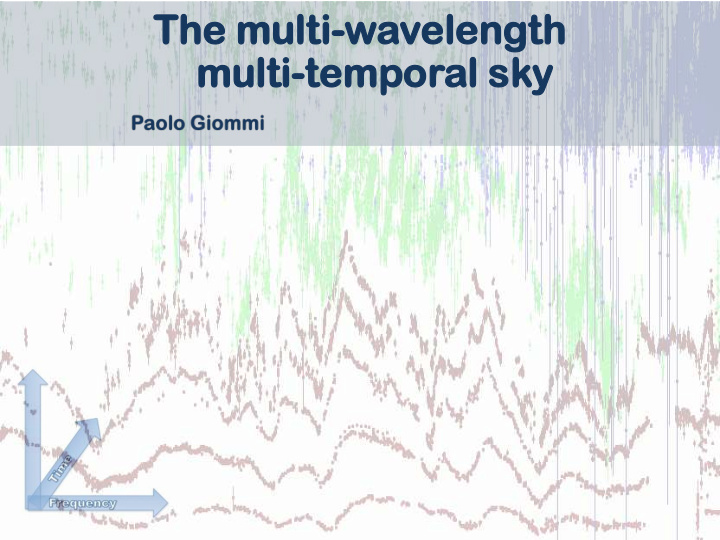



The he mul ulti ti-wavele elength ngth mul ulti ti-tempor temporal al sk sky
Radio/microwave band The electromagnetic spectrum Infra red band Optical band UV band X-ray band Υ -ray band TeV band
Radio/microwave band Infra red band Optical band UV band X-ray band Υ -ray band TeV band
Courtesy of M. Tavani
Typical Multi-Wavelength emitters: • Radio galaxies/Blazars • Pulsars/Pulsar wind nebulae (e.g. Crab) • GRBs
Gamma Ray Bursts as multi-frequency emitters GRBs were discovered in the 70's as gamma-ray sources, but only in the 90 ’s the precise positions obtained with the X-ray telescopes (e.g. BeppoSAX) enabled follow-up at optical, IR and radio wavelength, discovering the redshift and their host galaxies It is now possible to follow the time evolution of a GRB in a very wide energy range, and observe new features as a supernova related with a GRB HUBBLE SPACE TELESCOPE KECK VERY LARGE TELESCOPE Observations of GRB-SN 980425/1998bw VERY LARGE ARRAY
SUZAKU Swift AGILE RT2 Konus-WIND GRB 090618 Fermi Eiso=2.8x10 53 erg Z=0.54 Gemini North Newton Faulkes North Herschel telescope telescope
AGN : Two main categories 1. Dominated by (mostly) thermal emission from accretion disk - Radio quiet AGN (>~90 %) (normal QSO powered by accretion onto a SM black hole) 1. Dominated by Non-Thermal radiation – Jet dominated AGN (< 10%) When Θ < θ blazar Blazar As of today, about 3,150 blazars are known (Bzcat, edition 4.1, Massaro et al. 2012). This number is increasing rapidly but it remains a small percentage of the over one million AGN known Flesch, E. The Million Quasars (MILLIQUAS) Catalog, Version 3.1 (22 October 2012) http://quasars.org/milliquas.htm
The two blazar classes BL Lac object Flat spectrum radio quasar P. Padovani − Bologna High Energy 9 May 24, 2012 Meeting
Fermi adattive bin 1GeV light-curve Courtesiy of B. Lott Preliminary Accretion onto SMBH
Fermi adattive bin 1GeV light-curve Courtesy of B. Lott Preliminary
21
Fermi adattive bin 1GeV light-curve Courtesiy of B. Lott Preliminary
Planck, Swift Fermi observations of Radio and high-energy selected blazars Planck Collaboration 2011, A&A 563, A16 and Giommi et al. A&A 2012, 514, 160 - Large number of sources : 175 blazars observed by Swift when they were in the FOV of Planck: ~160 Swift ToOs - Simultaneous Planck Swift Fermi + ground based telescopes - Multi-selection approach . Four flux-limited samples. Radio (100 brightest northern sources) Soft X-ray (RASS, sample) Hard X-ray (Swift-BAT sample) γ -ray (Fermi sample)
3C 273 MKN 501 27
LBL/LSP 3C 279
3C 454.3 HBL/HSP MKN 421
IBL/ISP S5 0716+714 www.asdc.asi.it
The distribution of synchrotron peak energies 31
Testing the simplest scenario: homogeneous SSC (Thomson regime) 32
33
Compton Dominance 34
The distribution of Compton Dominance 35
36
37
38
39
40
Most (radio selected) FSRQs have Compton Dominance ~ 1 (Log(CD) = 0) 41
Multi-frequency astronomy is now a lot easier than in the past thanks to the many data centers that provide data, software and calibration for most existing observational facilities AND
Recommend
More recommend